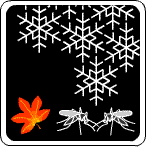Animals that Freeze Solid
Created | Updated May 17, 2013

We are all familiar with animals that hibernate through the winter, and with those that stay active all year round. There are also various other forms of dormancy. However, there is another group of animals that has taken a different route to winter survival. These actually freeze solid, and thaw out when the temperature rises again in spring.
Killer Ice Crystals
Normally, animals cannot freeze and thaw, because as their tissues freeze, ice crystals form in the spaces between their delicate cells. These crystals grow sharp spikes which break through the cell walls, rupturing and killing them.
Animals which follow the unusual path of freezing, which include gallfly larvae and, in America, freshwater turtles, contain special protein molecules which seed ice formation. Rather than allowing ice to form randomly, these seeds ensure that many small crystals are formed rather than the fewer, more damaging, large ones that would naturally occur. However, the story does not end there.
Cell Shrink-Wrapping
The fluids both inside cells and in the spaces between them consist of a number of salts, sugars and proteins dissolved in water. It is critical that the relative concentration of the fluids inside and outside the cells remains constant - a balance that is carefully maintained by the living cell membrane. Since ice is pure frozen water, when the fluid between the cells starts to freeze, the substances that were dissolved in it are forced to move out into the remaining unfrozen liquid. As even more of the fluid freezes, more dissolved chemicals pass into the unfrozen remainder, which becomes more and more concentrated. The balance between the concentrated liquid outside the cell and the more normal liquid inside it becomes upset.
In an attempt to maintain the balance between the inside and outside of the cell (after all, concentrated solutions tend to be poisonous), the living cell membrane allows water to flood out of the cell in an attempt to dilute the surrounding fluid. The cell can only take so much of this. The interior too becomes more and more concentrated, and as the water leaves, the cell shrinks, squeezing the essential structures within it. The process only stops when the external fluid is so concentrated that it can no longer freeze. By this point the cell of a normal animal would already be dead.
Antifreeze
In the autumn, as well as generating ice-seeds, many freeze-tolerant animals deliberately produce high concentrations of non-toxic antifreeze that raise the concentration of the bodily fluids without harming the cells, ensuring that the ice-forming process is halted before the cells become too compressed. This antifreeze also prevents the small seeded ice crystals, which are inherently unstable, from reforming over time into larger and larger crystals. In addition, special proteins are formed that protect the cell wall as it wrinkles up during shrinkage.
Once frozen, the animal still has to remain alive. Since all its internal organs are completely solid, essential movements such as heartbeats and breathing are impossible. The individual cells have to maintain the spark of life all through the winter using whatever resources they have within themselves; no new food or oxygen will arrive until the animal thaws out again.

